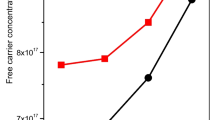Abstract
The article describes the results of the study of the microstructure and some electrophysical properties of silicon obtained by re-melting in a solar oven. It was found that the granularity of polycrystalline silicon consists of Si atoms with a size of 10–15 μm, the roughness of its surface. It is shown that at T ≤ 600 K the concentration of charge carriers increases due to an increase in the concentration of ionized impurity atoms, which, in turn, leads to a decrease in the resistivity of polycrystalline silicon. The position at T ~ 600–700 K is based on the decrease in the free path of the charge carriers as a result of thermal vibrations of the crystal lattice. The situation at T ≥ 700 K was explained by the emergence of new recombination centers specific to localized traps. Polycrystalline silicon heated by sunlight does not create a barrier effect of traps localized in the grain boundary regions from polycrystalline silicon obtained by other methods. This can expand the possibilities of creating highly efficient semiconductor devices, solar cells, thermoelectric materials for micro- and nanoelectronics, photovoltaics.
Similar content being viewed by others
Availability of Data and Materials
Y.
References
Harbek G (eds) (1989) Polycrystalline semiconductors. Physical properties and applications: (Moscow, Russia)
Kazmerskii L (eds) (1983) Thin polycrystalline and amorphous films. Physics and Applications. (Moscow, Russia)
Vavilov VS, Kiselev VF, Mukashev BN (eds) (1990) Defects in silicon and on its surface. (Moscow, Russia)
Olimov LO (eds) (2016) The grain boundaries of polycrystalline silicon: microwaves, charge states and p-n-junction. Autoreferaty of doctoral dissertation. (Uzbekistan)
Olimov LO, Abdurakhmanov BM, Teshaboev A (2014) Influence of alkali metal atoms on transport of charge carriers in the between grain boundaries of polycrystalline silicon. J Material Science 1:14
Olimov LO (2010) Model of the grain boundary in p-n structures based on polycrystalline semiconductors. J Applied Solar Energy 46:118
Abdurakhmanov BM, Olimov LO, Saidov MS (2008) Electrophysical properties of solar polycrystalline silicon and its n +-p structures at elevated temperatures. J Applied Solar Energy 44:46
Olimov LO (2012) Effect of alkali metals on the electronic properties of grain boundaries on a polycrystalline silicon surface. J Semiconductors 46:898
Olimov LO (2010) Adsorption of alkali metals and their effect on electronic properties of grain boundaries in bulk of polycrystalline silicon. J Semiconductors 44:602
Saidov MS, Abdurakhmanov BM, Olimov LO (2007) Impurity thermovoltaic effect in the grain boundaries of a polycrystalline silicon solar cell. J Applied Solar Energy 4:203
Olimov LO, Anarboev II, Mamirov A, Omonboev FL, Omonboeva ML (eds) (2021) Patent UZ № FAP 01593 "Method of preparation of thermoelectric material"
Gnidenko AA, Zavodinsky VG (2008) Effect of oxygen on structure and electronic properties of silicon nanoclusters Sin (n = 5, 6, 10, 18). J Semiconductors 42:800
Bratus’ VYa, Yukhimchuk VA, Berezhinsky LI, Valakh MYa, Vorona IP, Indutnyi IZ, Petrenko TT, Shepeliavy PE, Yanchuk IB (2001) Structural transformations and silicon nanocrystallite formation in SiOx films. J Semiconductors 35:821
Shigeki I, Masayuki F (2006) Formation of (111) nanotwin lamellae hillocks in polycrystalline silicon thin films caused by deposition of silicon dioxide layer. J Appl Phys Lett 88:021912
Acknowledgements
The work was done within India-Uzbekistan programme of co-operation in science & technology “Development and implementation of micro- and nanoscale (granulated) semiconductor thermoelectric materials”.
Author information
Authors and Affiliations
Contributions
Y.
Corresponding author
Ethics declarations
Ethics Approval and Consent to Participate
Y.
Consent for Publication
Y.
Competing Interests
No.
Conflict of Interest
No.
Research Involving Human Participants and/or Animals
No.
Informed Consent
Y.
Additional information
Publisher's Note
Springer Nature remains neutral with regard to jurisdictional claims in published maps and institutional affiliations.
Rights and permissions
About this article
Cite this article
Olimov , L., Anarboyev, I. Some Electrophysical Properties of Polycrystalline Silicon Obtained in a Solar Oven. Silicon 14, 3817–3822 (2022). https://doi.org/10.1007/s12633-021-01596-1
Received:
Accepted:
Published:
Issue Date:
DOI: https://doi.org/10.1007/s12633-021-01596-1




